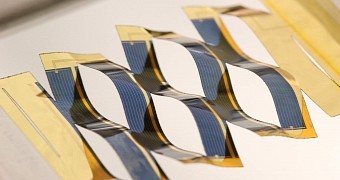University of Michigan researchers announced that they have developed a method of keeping solar cells constantly turned towards the sun without the need for energy-heavy motors.
Based on the ancient and beautiful Japanese art of Kirigami, a cousin of Origami that involves cuts besides folds, the new solar cells layout is printed on a flexible kapton substrate which has dash-like cuts running across the surface. If the material is stretched, the panel forms a mesh with each section twisting in slow motion. On each degree of twist, the panel will follow the position of the sun in the sky.
Basically, the design replaces a moving solid plate covered in solar cells into something essentially flat that continues to follow the sun via a smart stretching move.
However, it's interesting to see exactly how and what will power the small arms that stretch the panel. Apparently, the team considers the panels nearly as effective as conventional sun-tracking solar panels, as in being 36% more effective than stationary solar panels compared to 40 percent for traditional motorized units.
These new solar panels seem to be perfect for home installations, and it might reduce the cost of solar electricity for personal consumers. However, the main issue remains, how does the new solar cell panel get stretched over time? It will need some slow motion stretching by an external engine so the twisting panels track the sun.
Even though they probably fixed a part of the problem, the biggest issue still remains.

 14 DAY TRIAL //
14 DAY TRIAL // 